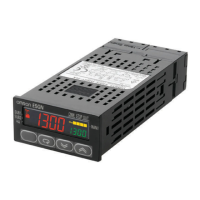4.1Shifting Input Values
E5GN
4–3
Ă• The input temperature range of nonĆcontact temperature sensors can
be shifted by setting an individual value for the upper and lower points
of the sensor range. This means that the shift can be applied equally
across the range with separate values for each end of the range. For
example, if the upperĆlimit value is set to 2_C" and the lowerĆlimit
value is set to 1_C", the sensor range is shifted by an average of 1.5_ C
at 50% input.
Ă• Set the upperĆlimit value in the upperĆlimit temperature input shift
value" parameter and the lowerĆlimit value in the lowerĆlimit temperaĆ
ture input shift value" parameter.
Input
Temperature
Upper-limit
value
Lower-limit value
Upper-limit temperature input shift value
After shift
Before shift
Lower-limit temperature
input shift value
100
0
JHow to calculate input shift values (2-point shift)
When the nonĆcontact temperature sensor model ES1A is connected to the
E5GN, an offset of several to several tens of a degree can occur.
For this reason, offset the readout value by 1Ćpoint or 2Ćpoint shift as
described in this item. This offset occurs as a bias current for detecting
controller sensor error flows to the output impedance of the nonĆcontact
temperature sensor. 2Ćpoint shift can be carried out only on nonĆcontact
temperature sensors, and cannot be set for other input types.
[Preparations]
(1) Set to the temperature range matching the input specifications of the
nonĆcontact temperature sensor. (ES1A is supported only in thermoĆ
couple input types on the E5GN.)
(2) Prepare a thermometer capable of measuring the temperature of the
control target as shown in Figure 1 so that 1Ćpoint shift or 2Ćpoint
shift can be carried out.
Figure 1 Configuration When Compensating a Non-contact
Temperature Sensor
Non-contact
temperature
sensor
(A) E5GN
(B) Thermometer
(C) Control target
F 2-point shift
Upper-limit
temperature
input shift
value
Lower-limit
temperature
input shift
value

